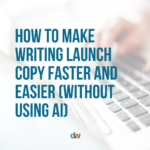How To Make Writing Launch Copy Faster and Easier (Without Using AI)
Picture this: you’ve created an awesome program to launch to your audience. You know it’s something they need and it truly solves the problem they’re facing.
You’re feeling super fired up about it until…
You sit down to write the copy for it.
Not only are you struggling with what to write for your sales page, but your sales emails feel like pulling teeth.
“Is this even how my audience feels? Will this resonate with them?”
All of these questions flood your mind and it makes creating content for social media even harder.
You just don’t know!
The problem here? It’s not that you’re a bad writer or that you don’t know your audience.
It’s simply that you skipped one HUGE piece of the launch process…
And that is defining your launch narrative.
If the word “narrative” doesn’t make sense to you, it’s simply the STORY that aligns what you’re selling with the problem your ideal audience is facing.
And no… the solution to writing your narrative isn’t just to turn to AI to do it for you.
Without a well defined narrative, your copy will likely fall flat because it won’t be able to fully connect with your reader.
This is why when people come to me and say that launching “doesn’t work” in their business, one of the first questions I ask is – what’s the narrative?
AKA what’s the story that you’re guiding your audience through so that they read your launch content and automatically think, “yep, that’s me! That’s exactly how I feel.”
Because honestly, if launching feels hard for you, I’m willing to bet it’s NOT because you don’t have a program that your audience needs. Or you don’t know how to sell. Or you don’t have an ideal audience waiting to buy from you.
Sometimes that’s the case, but typically a clear launch narrative is the solution for it all.
Ultimately, when you have the narrative right, your launch copy can be written 10x easier and faster and everything else starts falling into place – it’s the ultimate domino effect!

The good news? It’s not hard to create. In fact, there are four key pillars of your launch narrative and when you include each of these, you’re golden. ✨
4 Pillars of Your Launch Narrative
1. Problem
First up – the problem. This part should be fairly easy for you to put on paper.
But when you define the problem, the key is to take it 5 layers deeper. What are the SYMPTOMS your ideal customer is having because of the problem at hand?
Symptoms = the feelings and emotions that someone is experiencing
THAT is what you want your narrative to address!
For example, when creating LaunchFlow Accelerator, I knew it would be for the person who has tried launching in their business before, but felt like it “didn’t work.”
That’s the problem, but the SYMPTOMS are that they feel defeated, they think that no one wants to work with them, they’re questioning their work, etc.
In addition to the symptoms, it’s also important to call out the problem that your audience *think* exists and then provide a perspective shift.
Staying on my LaunchFlow Accelerator example, they might *think* that the only problem is their launch strategy (meaning how they launch). But I know that there’s more to it than that… but it’s still my job to speak to their current reality.
Next, consider who or what they’re blaming for the problem at hand and call attention to those things as well.
And finally (maybe most importantly), describe their problem EXACTLY how they would.
As business owners, we often try to create catchy phrases to include in our copy when really the BEST thing you can do is to write copy the way that your ideal audience would say it.
This is where your research comes in and is why I always encourage sending surveys to your audience and getting feedback directly from the source so you can use their language throughout your messaging.
2. Story
Once you know the problem and have it clearly defined, it’s time to craft the STORY.
This section of your launch narrative is where you convey why you “get it.” It’s where you get to talk about more of your background and explain how your personal experience or expertise (or both) allowed you to discover the solution.
You’ve just spent a ton of time describing their problem and making them feel heard, now it’s time to make them feel seen.
This is the part where they go, “wow! I’m not the only person who’s ever felt like this.”
Essentially, this piece of your messaging tells your audience that you know where they’re coming from, you know how they feel, and most importantly, you know a better way!
Here’s what this looks like in action:

3. Discovery
After telling more of your story, it’s time to move into that “aha moment” that YOU had that leads into the better way that you’re ready to reveal to them.
It’s in this moment that you give your audience a “it’s not that, it’s THIS” epiphany.
Remember how I mentioned that many times your audience believes that their problem is something different than what it really is? THIS is where you help them make that distinction!
The discovery section of your launch narrative clearly conveys why they’ve really been suffering.
For example, for LaunchFlow Accelerator, I help people understand that it’s not *just* their strategy that’s wrong – in fact, it may not be their strategy at all.
Instead, it’s 5 key things that must be in flow to create a fun, profitable, and repeatable launch!
4. Solution
Lastly, it’s time to introduce your solution! What does your audience TRULY need to solve their problem?
This is where your unique framework, solution, or offer comes into play.
But it’s not just about introducing your solution and listing off all the features that your program offers.
It’s about speaking to the BENEFITS and telling your audience what their world will look like when they have this!
Many times when writing copy, we tend to think that the more features we include, such as bonuses, Slack or Voxer access, a certain number of modules, etc. then that’s what will incline our audience to buy.
But the reality is that they don’t buy for the features at all. Your audience buys because of how they will BENEFIT from everything included.
HERE is a quick guide to help you move from feature to benefit in your copy!
Want To Nail Your Next Launch?
Overall, these four pillars work together to speak very specifically to your ideal customer and lead them to the ultimate solution of working with you.
If one of these is missing in your launch (whether it’s a masterclass, workshop, challenge, or even an email series), there’s a chance your audience will tune out at some point.
As a recap, here’s why:
➡️ They need to hear someone put their problem in words. When you clearly speak to what they’re thinking, feeling, and experiencing, they’ll keep listening.
➡️ They need to know that you *really* get it. This is why you can’t skip over your story! Why should they listen to you?
➡️ They need to see that you found a better way. Again, you can’t skip your story! Your turning point matters because it gives them hope that they can experience it, too.
➡️ They need to know that there’s a clear solution. All of the other pillars lead to this! Their opportunity to experience the better way.
Launching should feel fun, exciting, and energizing for you – not overwhelming, stress inducing, or panicky.
And if you craft the right narrative in place, you can experience the exciting side!
If you want to nail your next launch, grab the free LaunchFlow Roadmap to discover the 5 flows to create fun, profitable, and repeatable launches!
Now, this doesn’t necessarily mean that launching will suddenly become “easy.”
It will probably still feel intense and take a lot of work, but the difference is that you can know you’re doing the work in a way that’s RIGHT for you and your business specifically.
Download the LaunchFlow Roadmap so you can get first dibs on the next cohort of LaunchFlow Accelerator (opening January 2024) where we can work together to create a launch strategy and plan designed just for you.

